Butrint National Park: How to Visit Albania’s World Heritage Site

If you only do one excursion while in Saranda or Ksamil, you should visit Butrint National Park. The park is a rare combination of archeological history and nature, and it’s one of Albania’s UNESCO world heritage sites.
My dog and I visited Butrint National Park on our first visit to Saranda and had one the best days of our two months in Albania. Watson adored all the nature, and I loved all the ruins. Butrint is well worth a visit – it’s one of the best things to do in Albania.
How to Visit Butrint National Park in Albania
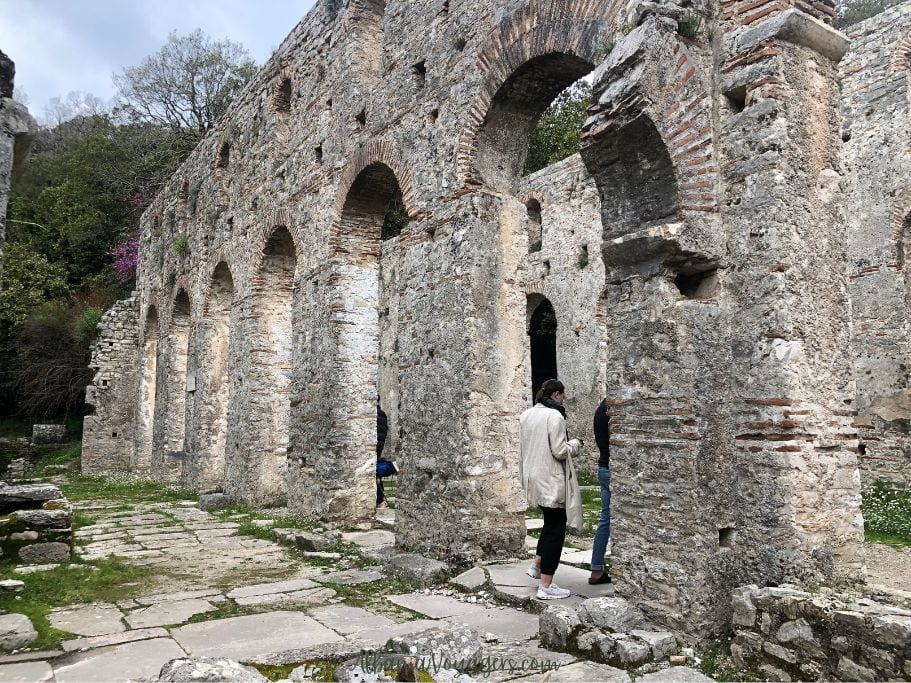
Butrint is down near the bottom of Albania, close to the Greek border. If you’re staying in Tirana, or Albania’s north it’s not practical to visit. But if you’re visiting Saranda, Ksamil or almost anywhere along the Albania Riviera, Butrint is easy to get to.
Planning a longer trip to Albania? See how I fit Butrint National Park into this two-week highlights of Albania itinerary, with both car and bus versions.
What is Butrint National Park?
Butrint National Park is one of Albania’s UNESCO world heritage sites. It’s an 86 square km nature reserve which includes Greek, Roman, Byzantine and Venetian ruins going back to 800 BC.
The unique location in nature makes this a very special site. UNESCO calls it “a microcosm of Mediterranean history.”
The park itself is beautiful, full of ancient ruins, walking trails and hundreds of species of flora. I saw my first wild calla lilies in Butrint.
Where is Butrint
Butrint National Park is in southern Albania, 17 km from Saranda and 4 km from Ksamil. It’s directly off of highway SH81, the coastal highway that runs between Saranda and Ksamil. It’s very close to the Greek border.
How to get to Butrint
You can get to Butrint by driving yourself (most flexible), bus (cheapest) or taxi (fastest). You can even walk there from Ksamil.
From Saranda
- By car: Drive straight down SH81 past Ksamil. The parking lot and entrance is by the water at Butrint Lake.
- By taxi: Saranda Eco Taxi charges 3000 lek ($36 USD) one way, or 8000 lek ($96 USD) for the return trip including 2 hours waiting.
- By bus: The Ksamil – Butrint bus costs 200 lek ($2.40 USD) and leaves from Rruga Skenderbeau across from the Basilica – Synagogue ruins. I took this bus to the Saranda beaches along Rruga Butrinti, and it was very crowded, and very late. Try to take an early one!
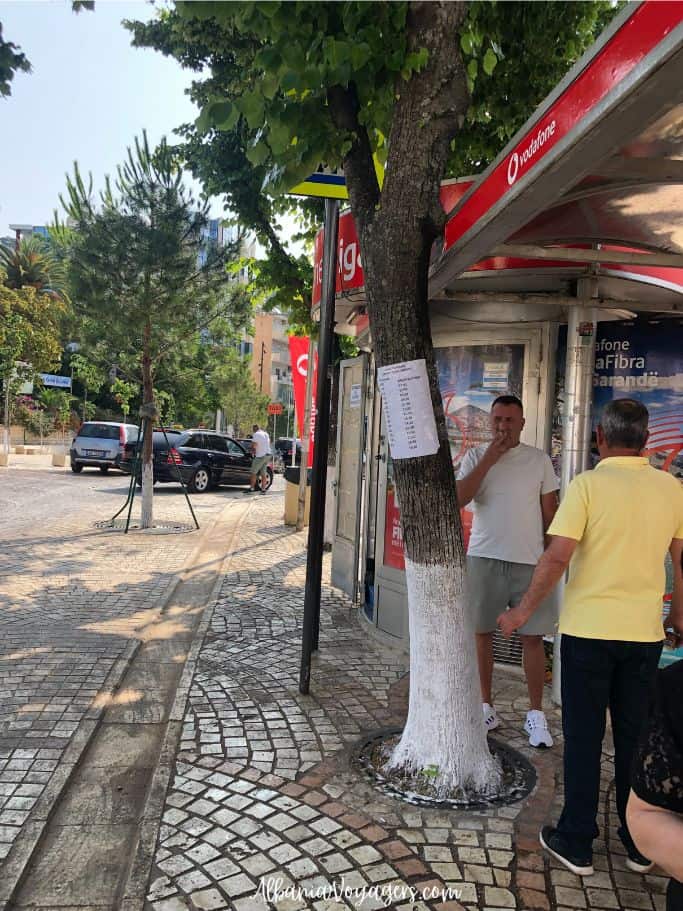
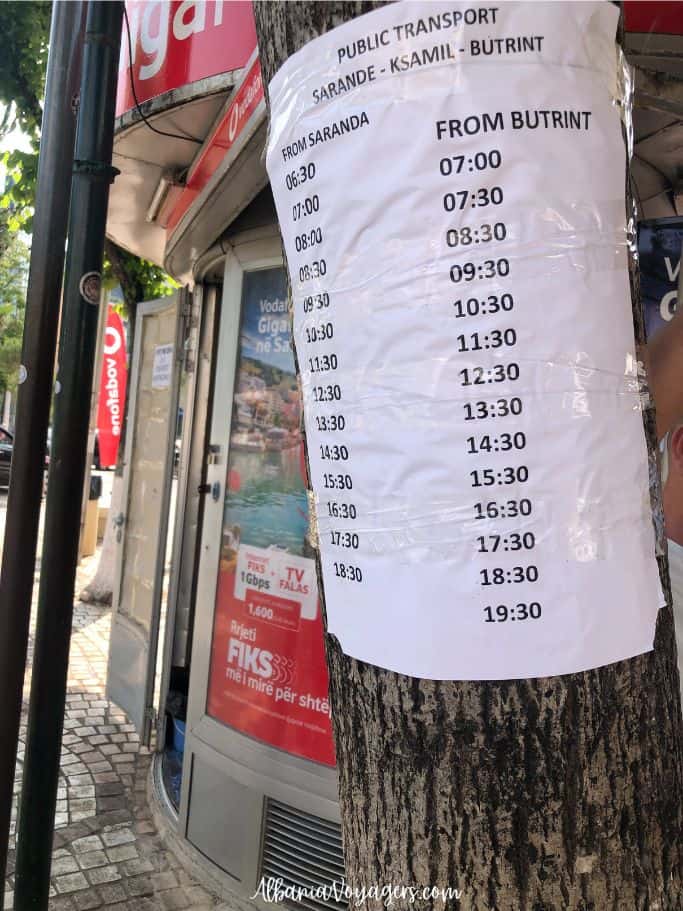
Prefer to take an organzied day tour?
⭐ I recommend this day tour from Saranda that includes the Blue Eye, Lekuresi Castle and Butrint National Park ⭐
From Ksamil
- By car: Drive straight down SH81. The parking lot and entrance is by the water at Butrint Lake.
- By taxi: I’m not sure of the exact fare from Ksamil, but it will be less than 1000 lek ($12 US).
- By bus: The Ksamil – Butrint bus. The bus stop is on SH81, across the street from Dancers Square at Rruga Tafil Buzi. The fare is 100 lek ($1.20 USD).
- On foot: Butrint National Park is 4.4 km from Ksamil. If you like hiking you can walk there. It takes about an hour.
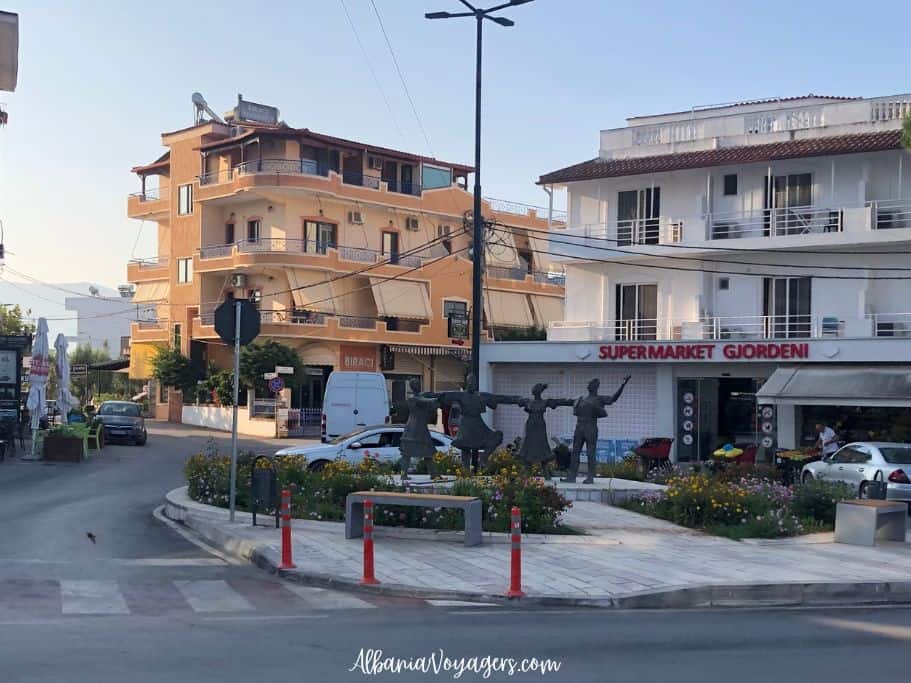
Opening Time & Cost
Check ahead to make sure the opening hours haven’t changed, or it’s not a national holiday and the park is closed.
Hours
- April 1st to October 31st: 8:30 am – 8:00 pm, daily (last entry 6:00 pm)
- November 1st to March 31st: 9:00 am – 5:30 pm, daily (last entry 3:00 pm)
Ticket Cost
- adult 1000 lek ($12 USD)
- senior/student 500 lek ($6 USD)
- children 12-18 years old 500 lek ($6 USD)
- children under 12 free
What to See When Visiting Butrint National Park
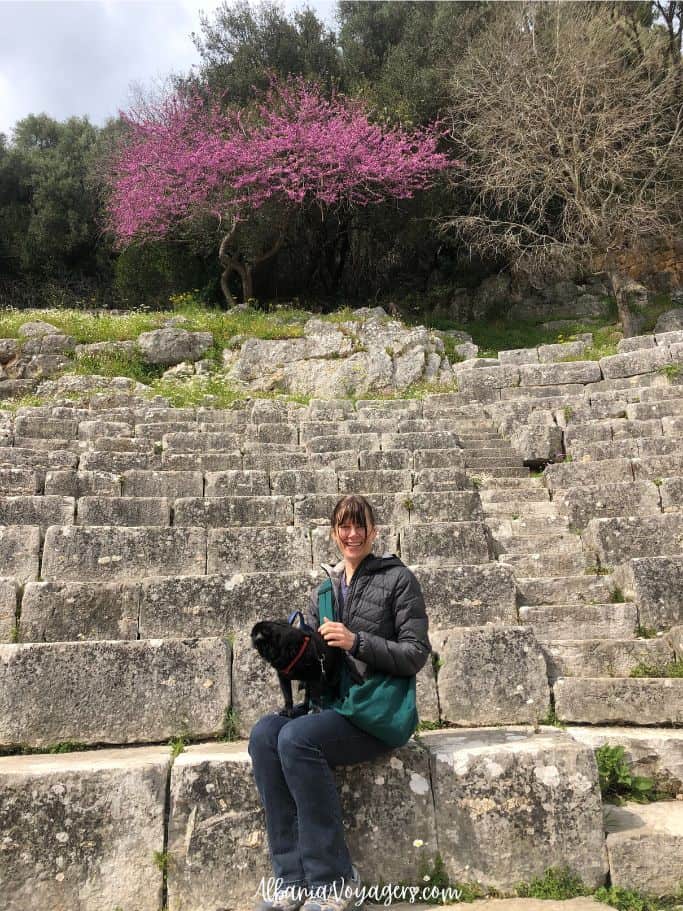
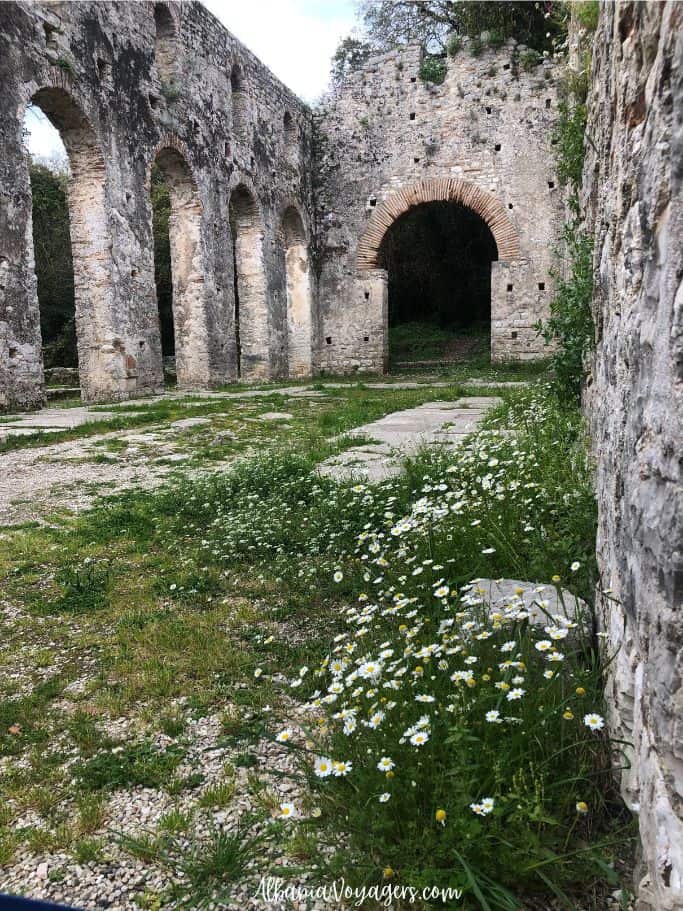
Butrint has ruins from multiple eras. Here are the most impressive sites to explore:
Ancient Theatre
A wonderfully preserved theatre from the 2nd century BC but probably on the site of an even earlier theatre. It could hold 2500 spectators. The names of slaves freed in honour of the Greek god Asclepius are inscribed on the surrounding walls. Excavation began in 1928, when the theatre was under several metres of dirt.
Sanctuary of Asclepius
Dedicated to the Greek god of medicine, Asclepius – the sanctuary was a very important place for the people of Butrint and beyond. Pilgrims would travel here to worship and leave offerings, and when it was excavated a number of Greek and Roman artefacts were discovered.
Great Basilica
This is one of the best preserved ancient churches in the Mediterranean, and I think the most impressive of the Butrint ruins. The Great Basilica was used as a church and burial site (graves were found during excavation). It was built in the 6th century AD and has a huge apse with 3 windows.
The Lion’s Gate
The Lion’s Gate is named for the relief of a lion devouring a bull above the entrance. The relief was not part of the original wall, but put there in the 5th century AD (the relief itself is much older).
The entrance was purposely made small so it would be easier to defend. Inside you’ll see the Spring of the Nymphs built in the 2nd century AD.
Lake Gate
Lake Gate is beside Butrint Lake, probably used for marine trade since the lagoon leads to the Ionian Sea. It was built in the 4th or 5th century AD. It’s believed it was in continued use for centuries with very little modification.
The Baptistery
The most remarkable of the Butrint ruins is the Byzantine era Baptistery. It’s unusual because of the circular shape (most were octagonal) and for the incredibly well preserved mosaic floor.
If you want to see the floor you’ll have to go to the museum and look at the pictures – the floor is completely covered over to protect the mosaics from flooding that occurs in this area. The mosaics are uncovered every few years for scientific study and public viewing.
Triconch Palace
Originally a Roman villa, it was later expanded into a palace around 420 AD. Archeologists believe the palace was abandoned before completion due to rising water levels.
Venetian Fortress
The Fortress was built by the Venetians in the 14th century to defend trading along the Ionian Sea. After the Venetians lost Butrint in 1537 to the Ottomans, the fortress fell into disrepair. The Butrint Museum is now in the fortress, and there’s great views of Butrint Lake and lagoon from the top.
Visitors’ Centre
A brand new visitors centre is under construction and supposed to open in September 2025. Kengo Kuma & Associates, Japanese architecture firm, was awarded the contact, and the plans look stunning.
Taking the Butrint Ferry Across Vivar Channel
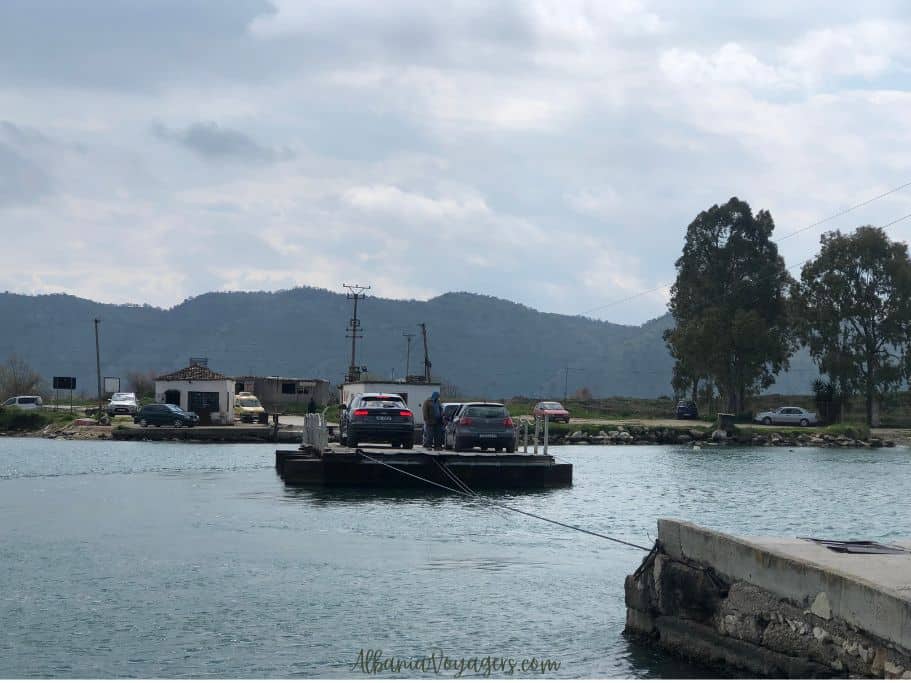
Directly across from the visitor parking lot is the dock for the Butrint ferry. The platform ferry takes cars and pedestrians across the Vivar Straight to the other side, a very short ride.
There’s more ruins on this side too, though not as remarkable as the ones in the main Butrint site.
There’s also walking and hiking trails. I have friends who come here and take the ferry just to access the trails.
The ferry takes 4 or 5 cars at a time and costs 500 lek ($6 USD), but pedestrians are free.
When to Go to Butrint National Park

Shoulder or off season is the best time to visit Butrint National Park. I was there in March and it was perfect. Hardly any people and the weather was great. I went with some friends, and we all brought our dogs who also had a wonderful time.
If you’re travelling to Albania in summer, go to Butrint early in the morning. Be there when they open! You’ll avoid the worst of the crowds and heat.
What to Expect When Visiting Butrint National Park
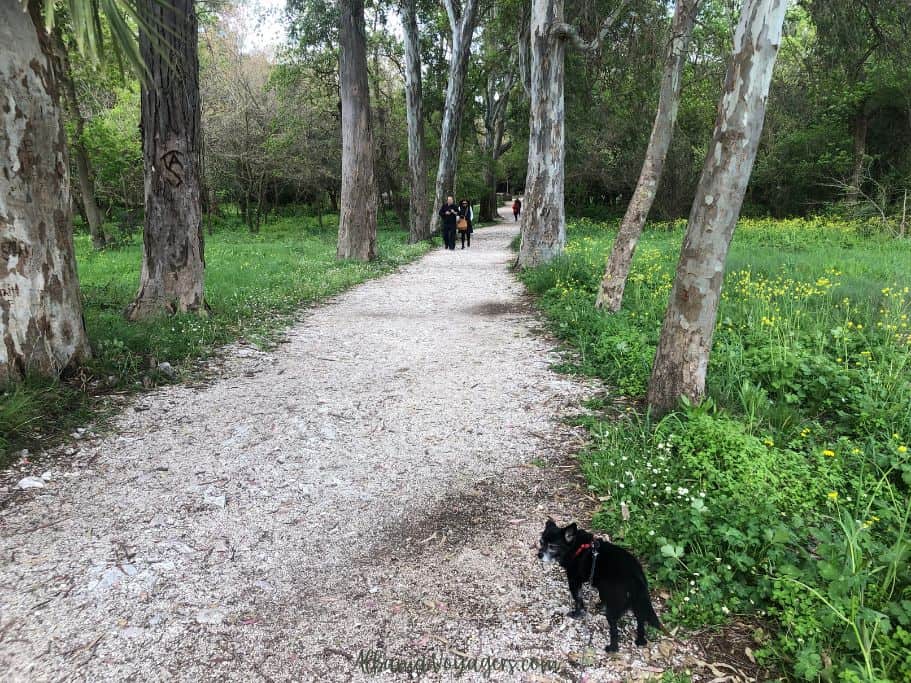
Even though the park is 86 square km, the area of the main ruins and fortress are not that spread out. There are lots of very walkable paths between ruins.
There’s quite a bit of shade on the paths, but some of the ruins are exposed to the sun. I recommend sun screen, a hat and water.
Because Butrint is in a natural setting surrounded by water, mosquitos can be a problem. Use mosquito repellent and long pants and sleeves. Walking shoes are also a good idea.
There are many species of flora and fauna. Keep your eyes open! I saw wild calla lilies down by the old walls and almond trees were blooming everywhere. Apparently the birding is good too.
In summer there are vendors, so bring cash in case you want to buy a souvenir.
If you visit Butrint National Park during summer (peak season) go early to avoid crowds and extreme heat.
Where to Stay Near Butrint
If you want to be very close to Butrint National Park, it’s best to stay in Ksamil. Ksamil is only 4 km from Butrint. You can even walk to the park if you want to!
Ksamil is a beach resort town and busy in summer, but if you like beaches you might enjoy it. Read my guide to Ksamil and see if it’s right for you. I’ve stayed in Ksamil and like these hotels:
Best budget: Vila Sun 2e
Best mid-priced: Emar Beachfront Hotel
Best luxury: Poda Boutique Hotel
Best quiet location: Galaxy Hotel
FAQs
These are common questions about visiting Butrint National Park:
3 hours is enough time to see Butrinti National Park at a leisurely pace. You could stay longer and bring a picnic lunch, or take the Butrint ferry across Vivar Straight to see the ruins on the other side.
The adult entrance fee is 1000 lek ($12 USD), and 500 lek ($6 USD) for seniors, children and students. Children under 12 are free.
It’s best to wear long sleeves and pants as mosquitos can be an issue depending on the season. Sun screen and a hat are recommended in summer.
Last Words on Butrint National Park: How to Visit Albania’s World Heritage Site
I hope you’re inspired to visit Butrint National Park in Albania. The ruins are in great condition, and it’s a very unique location within a national park and wetlands.
I truly think visiting Butrint National Park is one of the best things you can do in southern Albania.
